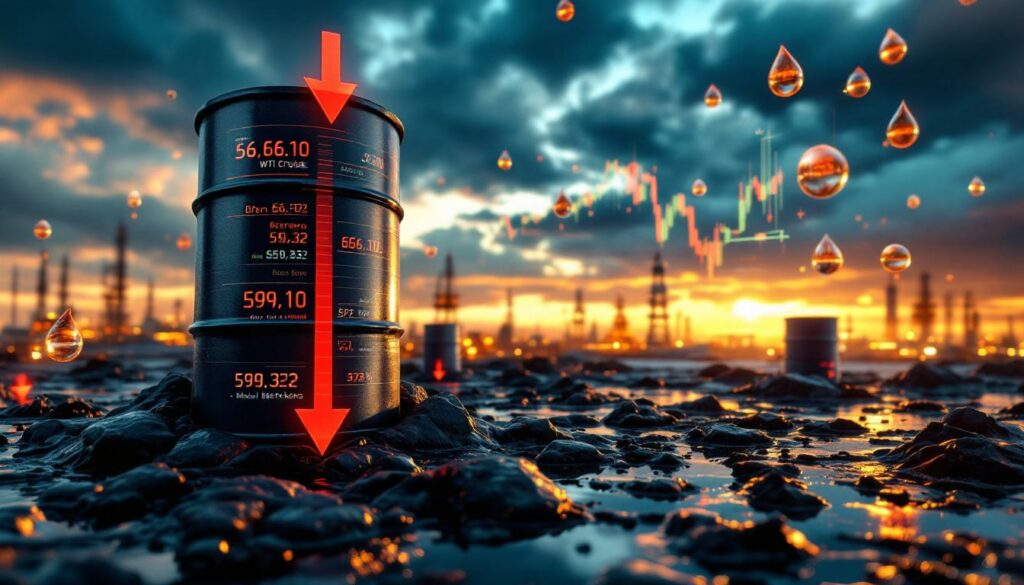What Are the Current Crude Oil Prices Today?
Global oil markets continue to experience significant volatility in 2025, with crude oil prices today reflecting a complex interplay of supply constraints, geopolitical tensions, and evolving demand patterns. Current crude oil benchmarks show WTI trading at $67.10 per barrel (down 1.97%) and Brent at $69.32 (down 1.48%), highlighting the ongoing price pressures facing the market.
According to real-time data from Oilprice.com, the downward momentum in crude oil prices today extends across most major benchmarks, with only select grades showing resilience against the broader market selloff. This divergence in performance underscores the importance of understanding regional dynamics when analyzing current oil prices.
Understanding Today's Oil Market Dynamics
The current oil price movements occur against a backdrop of record global consumption reaching 101.8 million barrels per day in 2024, according to the 2025 Statistical Review of World Energy. Despite this demand milestone, prices remain subdued compared to historical levels, suggesting supply adequacy in the near term.
Market analysts point to the combination of robust U.S. production, strategic reserve activities, and evolving consumption patterns as key factors influencing crude oil prices today. The daily fluctuations reflect both immediate market sentiment and longer-term structural shifts in the global energy landscape.
How Do Different Oil Benchmarks Compare Today?
Understanding the relationship between different crude oil benchmarks provides essential context for interpreting current market conditions. Each benchmark represents oil with specific quality characteristics traded in particular geographic regions.
Major Global Crude Oil Benchmarks
| Benchmark | Current Price | Daily Change | Percentage |
|---|---|---|---|
| WTI Crude | $67.10 | -$1.35 | -1.97% |
| Brent Crude | $69.32 | -$1.04 | -1.48% |
| Murban Crude | $70.69 | -$0.86 | -1.20% |
| Louisiana Light | $72.43 | +$1.85 | +2.62% |
| Bonny Light | $78.62 | -$2.30 | -2.84% |
| OPEC Basket | $70.77 | -$0.46 | -0.65% |
The price spread between different benchmarks reflects regional supply-demand dynamics, quality differentials, and transportation costs. Premium grades like Bonny Light command higher prices due to their lower sulfur content (below 0.2%) and higher API gravity (33-35°), which yields more valuable refined products such as gasoline and diesel.
Louisiana Light's notable 2.62% gain stands in contrast to the broader market decline, potentially reflecting specific Gulf Coast refining demand or localized supply constraints. Meanwhile, the OPEC Basket's relatively modest decline (-0.65%) demonstrates how the cartel's production discipline can buffer price volatility.
What Factors Are Driving Oil Prices Down Today?
Several key factors are contributing to the current downward pressure on crude oil prices, creating a challenging environment for producers while potentially benefiting consumers and oil-importing nations.
Supply-Side Pressures
- OPEC+ production decisions remain central to market dynamics, with recent statements indicating the group believes $18.2 trillion in oil and gas investments will be needed by 2050 to meet global demand
- U.S. production resilience continues despite some companies like Occidental Petroleum flagging lower production in their Q2 earnings reports
- Strategic Petroleum Reserve (SPR) activities, including a DOE-approved 500,000-barrel exchange with Exxon to address crude quality issues, are adding incremental supply to the market
The interplay between these supply factors creates downward pressure on crude oil prices today, with market participants closely monitoring production discipline among major suppliers.
Demand Concerns
- China's economic challenges have resulted in a 1.2% year-over-year decline in oil consumption to 16.4 million barrels per day, according to the 2025 Statistical Review of World Energy
- Seasonal consumption patterns are evolving, with traditional summer demand uplifts partially offset by changing travel behaviors
- Transportation electrification continues in major markets, with electric vehicle sales growing at double-digit rates in Europe and China
Standard Chartered analysts note that "China's slowing demand and India's surge are rebalancing global oil flows. U.S. shale resilience can't fully offset OPEC+ volatility," highlighting the shifting centers of gravity in global oil consumption.
Geopolitical Considerations
- Policy uncertainty regarding potential U.S. energy statements has created cautious market sentiment
- Regional tensions in key producing areas continue to present supply risk premiums
- Trade negotiations, such as Indonesia tying increased U.S. oil purchases to reduced tariffs, demonstrate how energy markets increasingly intersect with broader economic diplomacy
These geopolitical factors add layers of complexity to crude oil price forecasting, creating both risks and opportunities for market participants.
How Are Regional Oil Prices Performing?
Regional crude oil prices provide valuable insights into local market conditions, quality differentials, and logistical constraints that affect global energy flows.
North American Crude Varieties
| Crude Type | Price | Daily Change | Percentage |
|---|---|---|---|
| WTI Crude | $67.10 | -$1.35 | -1.97% |
| Western Canadian Select | $56.10 | $0.00 | 0.00% |
| Canadian Condensate | $70.60 | $0.00 | 0.00% |
| Eagle Ford | $64.93 | +$1.88 | +2.98% |
| Domestic Sweet @ Cushing | $64.93 | +$1.88 | +2.98% |
North American crude varieties show mixed performance, with Eagle Ford's notable 2.98% gain reflecting strong demand from Gulf Coast refineries optimized to process this light, sweet crude. The substantial discount for Western Canadian Select ($56.10) illustrates the persistent challenges facing Canadian producers due to pipeline constraints and quality differentials.
International Crude Varieties
| Crude Type | Price | Daily Change | Percentage |
|---|---|---|---|
| Brent Crude | $69.32 | -$1.04 | -1.48% |
| Murban Crude | $70.69 | -$0.86 | -1.20% |
| Iran Heavy | $64.96 | -$0.76 | -1.16% |
| Basra Light | $71.69 | -$3.60 | -4.78% |
| Saharan Blend | $68.65 | -$0.72 | -1.04% |
The international crude market shows notable divergence, with Basra Light's dramatic 4.78% decline standing out among its peers. This sharp drop reflects specific pipeline disruptions in southern Iraq that have constrained exports, according to recent Oilprice.com reporting. The relatively modest decline in Iran Heavy (-1.16%) suggests that sanctioned Iranian crude continues to find pathways to market despite international restrictions.
What's Happening with Natural Gas and Refined Products?
Beyond crude oil, energy markets show varied performance across natural gas and refined petroleum products, adding important context to the broader energy landscape.
-
Natural Gas: Trading at $3.448 per MMBtu, up 4.04% today, marking its highest level in three months. This strength comes despite the traditional summer lull, potentially signaling structural supply tightness. As one Oilprice.com headline notes, "Asian heat waves are squeezing LNG flows to Europe," creating global ripple effects.
-
Gasoline: Currently at $2.169 per gallon, down 0.83%, reflecting crude price weakness but moderated by peak summer driving demand. The smaller percentage decline compared to crude oil (-1.97% for WTI) indicates refiners are maintaining healthy margins during the high-demand season.
-
Heating Oil: Prices are tracking broader market trends with modest declines, though winter inventory building typically begins in late summer, which could provide price support in coming weeks.
These interconnected markets provide additional context for understanding the overall energy landscape, with US natural gas forecast strength potentially signaling broader energy market tightness despite crude oil price weakness.
How Has Global Oil Consumption Evolved?
Recent data from the 2025 Statistical Review of World Energy reveals significant shifts in global oil demand patterns that are reshaping market dynamics and future price trajectories.
-
Global consumption reached an all-time high of 101.8 million barrels per day in 2024, demonstrating oil's continued centrality in the global energy mix despite energy transition efforts
-
Growth was primarily driven by non-OECD countries, with overall demand increasing 0.7% year-over-year, a modest rate that reflects both economic growth and efficiency improvements
-
The United States remains the largest consumer at 18.7% of global demand, maintaining its position despite ambitious decarbonization targets
-
China's consumption declined 1.2% to 16.4 million bpd, potentially signaling a plateau in what has been the engine of global demand growth for two decades
-
India's consumption surged 3.1% to 5.6 million bpd, positioning it to become the third-largest consumer globally in the coming years
Robert Rapier of Oilprice.com notes that "China's oil demand may be plateauing due to economic headwinds and electrification. India's surge positions it as the next demand heavyweight," highlighting the shifting center of gravity in global oil markets toward emerging economies.
These consumption patterns underscore the complex regional dynamics influencing crude oil prices today, with traditional demand centers showing maturity while emerging economies drive incremental growth.
Who Are the Leading Oil Producers Today?
The global production landscape continues to evolve, with significant implications for market balances, trade flows, and price formation.
-
Global output reached a record 96.9 million barrels per day in 2024, according to the Statistical Review of World Energy, yet still fell short of consumption (101.8 million bpd)
-
The United States leads with 20.1 million bpd total production (13.2 million bpd crude oil and condensate), cementing its position as the world's largest oil producer
-
Russia follows at 10.2 million bpd, down 3.1% due to sanctions, logistical constraints, and market access challenges
-
Saudi Arabia's production fell 4.2% to 9.2 million bpd, its lowest level since 2011, reflecting the kingdom's role in OPEC+ production restraint
-
Guyana has emerged as a significant producer, reaching over 600,000 bpd from zero just five years ago, demonstrating how rapidly new supply sources can develop
These production trends reflect both strategic decisions by major producers and the emergence of new supply sources. The growing gap between global consumption (101.8 million bpd) and production (96.9 million bpd) explains the steady drawdown in global inventories despite relatively modest crude oil prices today.
What Do Current Oil Price Trends Mean for Investors?
For investors monitoring oil markets, several key considerations emerge from today's price environment and underlying fundamentals.
Short-Term Outlook
- Price volatility likely to continue amid geopolitical uncertainties, with crude oil prices today reflecting immediate market sentiment rather than long-term fundamentals
- OPEC+ production decisions remain crucial for market stability, with the group's cohesion being tested by divergent fiscal needs among members
- Seasonal demand patterns may provide temporary support, particularly if summer cooling demand sustains natural gas prices and creates spillover effects
Investors with shorter time horizons should monitor weekly inventory reports, refinery utilization rates, and production discipline among major producers.
Medium-Term Considerations
- U.S. shale productivity and investment trends show signs of moderation, with production growing just 2% in 2024 compared to the 4.2% average over the past decade
- Emerging market demand growth trajectories, particularly India's sustained 3%+ annual increases, will shape global balances
- Refining capacity constraints and product spreads merit attention as the gap between crude oil prices and refined product values creates opportunities for midstream and downstream operators
The medium-term outlook suggests a gradually tightening market as demand growth continues to outpace capacity additions in both production and refining.
Long-Term Strategic Factors
- Energy transition impacts on oil demand growth will accelerate, though the pace remains uncertain and varies significantly by region
- Investment in new production capacity faces increasing scrutiny from environmental, social, and governance (ESG) perspectives despite OPEC's assertion that $18.2 trillion in oil and gas investments are needed by 2050
- Geopolitical realignments affecting trade flows continue to reshape historical patterns, with implications for regional price differentials
Long-term investors should consider portfolio diversification across the energy value chain while monitoring the evolving regulatory landscape around carbon intensity and emissions.
What Recent News Is Affecting Oil Markets?
Several recent developments are influencing market sentiment and contributing to the current crude oil price environment:
-
Argentina's $16 billion YPF legal battle received a temporary reprieve, potentially averting immediate market disruptions in one of Latin America's major producers
-
OPEC claims the world needs $18.2 trillion in oil and gas investments by 2050, signaling the group's view on long-term hydrocarbon relevance despite energy transition pressures
-
Occidental Petroleum flagged lower production and oil price impacts in its Q2 earnings preview, suggesting challenges even for efficient U.S. producers in the current price environment
-
Indonesia is tying increased U.S. oil purchases to reduced tariffs, demonstrating how energy trade is increasingly leveraged in broader economic negotiations
-
The U.S. Department of Energy approved an exchange from the Strategic Petroleum Reserve to Exxon to address crude quality issues, highlighting the strategic importance of maintaining appropriate crude slates for refinery operations
-
Puerto Rico faces an energy crisis amid disputes with LNG suppliers, showcasing the vulnerability of isolated energy markets to supply disruptions
-
Asian heat waves are squeezing LNG flows to Europe, creating global natural gas market tightness that could indirectly support crude oil prices through fuel switching
-
Saudi Arabia's production increase has sparked credibility concerns among market participants, potentially undermining confidence in OPEC+ cohesion
These developments highlight the complex interplay of supply, demand, and geopolitical factors shaping crude oil prices today, requiring market participants to monitor both traditional fundamentals and emerging structural shifts.
What's the Outlook for Crude Oil Prices?
While short-term price predictions remain challenging, several structural factors will influence crude oil markets and prices in the coming months and years:
Supply Dynamics
- OPEC+ cohesion will be tested as members balance market share concerns against price support objectives
- U.S. production growth rates show signs of moderation (2% in 2024 vs. historical 4.2% average)
- New producer emergence, exemplified by Guyana's rapid rise to 600,000 bpd, demonstrates how frontier regions can quickly impact global balances
The supply outlook suggests potential tightening as investment constraints limit capacity additions in the face of continued demand growth.
Demand Trends
- China's economic trajectory remains crucial despite recent consumption declines (-1.2% in 2024)
- India's continued growth (+3.1% in 2024) establishes it as the primary engine of global demand expansion
- Transportation electrification pace varies significantly by region, with Europe and China leading while developing economies lag
The demand outlook remains positive despite energy transition pressures, with total consumption likely to continue rising through at least 2030 based on current trends.
Geopolitical Factors
- Middle East tensions present ongoing supply disruption risks despite seeming market complacency
- Russia-Ukraine conflict evolution continues to reshape global energy flows and trade war implications for oil markets
- U.S. policy shifts could significantly impact global market access and investment patterns
Geopolitical risk premiums remain surprisingly subdued in current crude oil prices today, suggesting potential upside risks if tensions escalate.
Energy Transition
- Renewable energy adoption rates continue accelerating, though still insufficient to offset hydrocarbon demand growth in most regions
- Policy frameworks around carbon pricing and emissions targets introduce compliance costs throughout the value chain
- Investment patterns increasingly reflect ESG considerations despite OPEC's assertion that $18.2 trillion in oil and gas investments are needed by 2050
The energy transition creates both headwinds for long-term demand growth and challenges for capacity addition, potentially supporting prices even as absolute consumption eventually peaks.
Market participants should prepare for continued volatility while monitoring these fundamental drivers that will shape crude oil prices through the remainder of 2025 and beyond.
Conclusion: Navigating Today's Complex Oil Market
Current crude oil prices reflect a market in transition, balancing traditional supply-demand fundamentals against emerging structural shifts. With WTI at $67.10 and Brent at $69.32, prices remain well below recent historical peaks but still provide economic incentives for
Want to Catch the Next Major Mineral Discovery?
Stay ahead of the market with Discovery Alert's proprietary Discovery IQ model, which delivers instant notifications when significant ASX mineral discoveries are announced. Explore how major discoveries can lead to substantial returns by visiting Discovery Alert's dedicated discoveries page and begin your 30-day free trial today.




